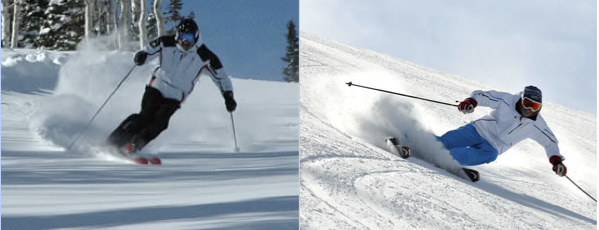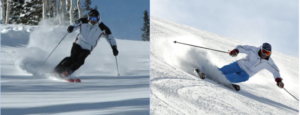The Cutting Edge:
What Separates Great Skiers from Good Skiers Isn’t Their Skis
This reverie may strike some readers as an odd blog entry from a person who writes over 200 ski reviews a season, but chances are a new ski won’t change your skiing as much as learning how to use the tools you have. (There are exceptions, of course, but we’ll deal with them later.) Without getting too deeply into the details, until you learn how to first tip and then bend a ski, you’re in a poor position to judge the performance parameters of any ski you assay.
This doesn’t mean you won’t admire one ski and despise another; it just means your assessment is less likely to be an accurate reflection of the ski’s possibilities and more a commentary on your own capacities. The unfortunate fact is that most skiers, despite what they feel are mighty exertions, ski passively. They don’t seem to grasp that “tip” and “bend” are active verbs. We aren’t going to embark on a ski lesson here—that’s better left to our collaborators John Clendenin, Harald Harb and Chris Fellows—but we do want to stress the link between technique and ski preference.
The best skiers on the hill get to the edge early and know how to adjust their stance to find to a high edge angle, if need be, or feather the turn into whatever shape they like. Regardless of the amount of effort expended, we at realskiers consider such elite technicians to be “Power” skiers because they know how to extract the maximum energy from the ski. They will appreciate ski designs that allow them to exploit all their talents, and do so at speeds that would make the average skier terrified. The relaxed skier on the right, above, is cruising along at roughly 45mph, in a clean carve and with minimal expenditure of energy. The skier on the left, while a good strong skier, is using a lot of energy to push snow around and is far from relaxed at only 20mph.
Most skiers who would self-assess as “advanced” rarely, if ever, rake their skis up on a radical edge angle. If they apply pressure somewhere in the turn, it’s usually too little and too late. They feel like world-beaters on soft groomers and occasionally, miraculously, this sensation translates to off-piste terrain. But arrhythmic bumps and clumpy crud are more work than they’re worth and deep snow is exhausting. They dearly hope there’s a ski that will make the entire mountain as simple to ski as plush-pillow soft groomers.
Turns out, there are lots of skis made for these “Finesse” skiers, as we refer to them in realskiers’ parlance. They’re geared to make access easier for the average advanced skier, which will definitely make said skier happier, but not necessarily more competent. In fact, these more docile models usually surrender some high-end qualities—such as early edge contact—in order to improve tractability.
Allow me to illustrate using a fairly extreme example but one drawn directly from real life and thus irrefutable. The scene unfolds three seasons ago, an abundant snow year, at Snowbird, where this abundance routinely found expression in two-foot dumps. A friend of a friend—let’s call him Nigel, as that was his name—was in way over his head, literally and figuratively. Immediate intervention was required.
First, Nigel needed new boots. We directed him into a better boot than Nigel was a skier because they gave him the best chance of survival on Snowbird’s infamous front face. For skis, we procured a well-loved pair of K2 Pontoons from the demo fleet at Alta Sports. The next day I observed Nigel coming down Silver Fox through two feet of variable chop as if he were on a Sunday stroll. He was beaming with undisguised delight.
Had Nigel discovered in his dreams how to ski a ragged powder field? No, Nigel still stood on his skis like an overstuffed bag of groceries. Whatever weight transfer occurred was gravity-induced, with the giant skis swiveling about underfoot providing an unshakable platform. The Pontoon’s Coupe de Ville-sized surface area flattened everything in Nigel’s path, safely chaperoning him in utter bliss down to the Plaza.
We trust the lucid reader has extracted from this episode its intended lesson: a ski that makes your day easier isn’t necessarily making you better. Getting more to the point, as an industry we’ve been pushing people into wider and wider platforms, with ever more exaggerated rockers along the baseline. Easy to stand on but less likely to be aggressively edged, the modern ski has emboldened many skiers of dubious skills. When a lot of people on the slope are on fast, uncontrolled trajectories, traffic safety is compromised.
As an on-the-record advocate of 98mm wide skis as all-mountain tools for men, I’ve played my part in over-promoting width. If only more 88’s were made in the same rich constructions as their fatter brothers, more male skiers would find universal peace and happiness on the narrower profile—and make cleaner, more accurate turns. Such 88’s exist today in the exquisite Kästle MX 88 and Head Rev Pro 85, both of which actually outperform their big (98mm) brothers, and the new Blizzard Brahma, which may not be better than the universally acclaimed Bonafide but is certainly not one iota worse.
For skiers who have mastered fluid movement in all terrain, all the fretting over what kind of ski to get may sound sort of silly. They can get down anything more or less as they please with whatever ski is handy. I’ve seen just about every mismatch between man and terrain imaginable; in every instance, the right set of feet overcame the wrong set of skis. There’s no question that certain skis make certain types of skiing a whole lot easier, but great skiers with a complete skill set are never on the wrong ski.



